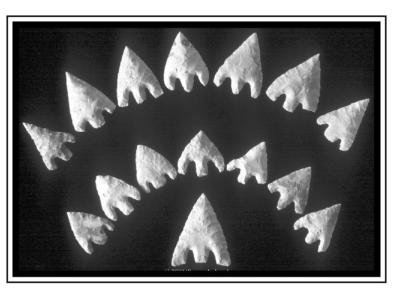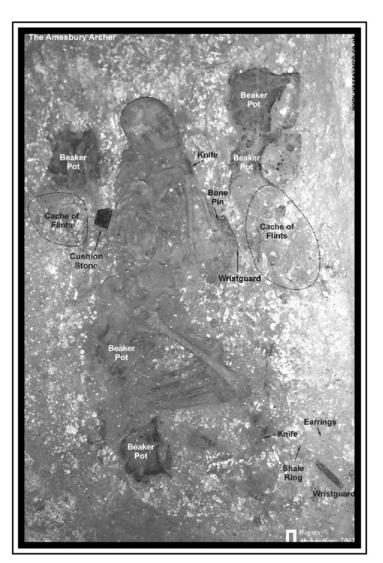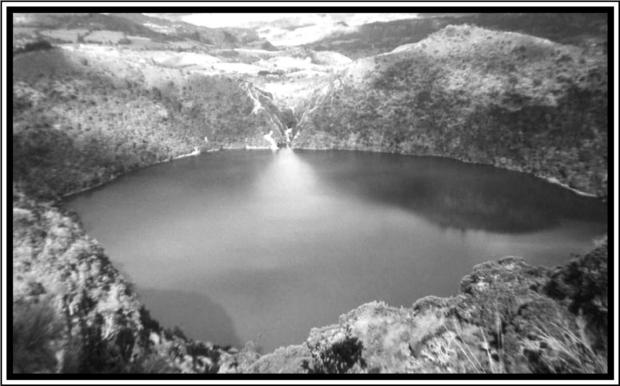Hidden History: Lost Civilizations, Secret Knowledge, and Ancient Mysteries (14 page)
Read Hidden History: Lost Civilizations, Secret Knowledge, and Ancient Mysteries Online
Authors: Brian Haughton
Tags: #Fringe Science, #Gnostic Dementia, #U.S.A., #Alternative History, #Amazon.com, #Retail, #Archaeology, #History


Photograph by the author.
Detail of Stonehenge, showing the huge sarsen stones.
It was also in Phase III at Stonehenge that the northeastern entrance
to the enclosure was widened so that
it precisely aligned with the midsummer sunrise and midwinter sunset of
the period. Another feature added to
the Stonehenge landscape during this
phase was the Avenue, a ceremonial
pathway consisting of a parallel pair
of ditches and banks stretching for 1.86
miles from the monument down to the
River Avon.
Around 2300 B.C. the bluestones
were dug up and replaced by enormous
sarsen stones brought from the
Marlborough Downs, 20 miles away.
The sarsens, each around 13.5 feet
high, 6.8 feet wide, and weighing
around 25 tons, were arranged in a 108
foot diameter circle with lintels (horizontal stones) spanning the tops.
Within this circle a horseshoe-shaped
setting of five trilithons (two large
stones set upright to support a third
on their top), of dressed sarsen stone,
was added, its open end facing northeast. The enormous stones, which
made up the central horseshoe arrangement of 10 uprights and five lintels, weighed up to 50 tons each. Later
in this period, between 2280 to 1930
B.C., the bluestones were re-erected
and arranged at least three times, finally forming an inner circle and
horseshoe between the Sarsen Circle
and the Trilithons, mirroring the two
arrangements of sarsen stones. It is thought that more bluestones were
transported from Wales to the site at
this time. Between 2000 and 1600 B.C.
a double ring of pits, known as the
Y and Z holes, were dug outside the
outermost sarsen circle, possibly to
take another setting of stones. However, for whatever reason, no stones
were added and the pits were allowed
to silt up naturally. After 1600 B.C.
there was no further construction at
Stonehenge, and the monument appears to have been abandoned. Nevertheless, the site was still occasionally
visited, as is evidenced by finds of Iron
Age pottery, Roman coins, and the
burial of a decapitated Saxon man
dated to the seventh century A.D.
There has been considerable speculation as to how Stonehenge was built.
An experiment in the 1990s showed
that a team of 200 people, using a
wooden sledge on laid timber rails covered with grease, could have transported all 80 sarsens from the
Marlborough Downs to Stonehenge in
two years, or longer if the work was
seasonal. The experiment illustrated
that the maneuvering of the stones
into position could have been accomplished using timber A-frames to
raise the stones, which could then
have been hauled upright by teams of
people using ropes. The lintels may
have been raised up gradually on timber platforms and levered into position when the primitive scaffolding
reached the top of the upright stones.
A fascinating aspect of the construction of Stonehenge is that the stones
were worked using carpentry techniques. After being hammered to size
using stone balls known as mauls, examples of which have been found at the
site, the stones were fashioned with
mortise and tenon joints so that the
lintels could rest securely on top of the
uprights. The lintels themselves were
joined together using another woodworking method known as the tonguein-groove joint.
Much more interesting than how
Stonehenge was built is why it was
built. Unfortunately, for such an important structure the archaeological
finds from Stonehenge have been relatively meager. This is partly due to the
fact that until the last couple of decades
research at the site had been, on the
whole, poorly performed and insufficiently documented. Skeletons were
lost or seriously damaged, artifacts
misplaced, and excavation notes
destroyed. Despite these losses, the
evidence from surviving burials discovered at or near the site gives a fascinating insight into the lives of Early
Bronze Age peoples in the area.
The main burials at Stonehenge
are all broadly contemporary with
each other, dating from 2400 B.c.-2150
B.C. (the Early Bronze Age period). Examination of a skeleton buried in the
outer ditch of the monument revealed
that the man had been shot at close range by up to six arrows, probably
by two people, one shooting from the
left, the other from the right. Was this
an execution or some form of human
sacrifice? Another astonishing burial
was found in 2002 at Amesbury, 2.8
miles southeast of Stonehenge, and has
become known as either the Amesbury
Archer or the King of Stonehenge. The
rich goods found with this burial indicate a high-status individual, and include five Beaker pots, 16 beautifully
worked flint arrowheads, several boar
tusks, two sandstone wristguards (to
protect the wrists from the bow string
of a bow and arrow), a pair of gold hair
ornaments, three tiny copper knives,
and a flint-knapping kit and metalworking tools. Not only are the gold
objects the oldest ever found in Britain, but this person may have been one
of the earliest metalwokers in the islands. Tests on the skeleton show that
the Archer was a strongly built man
aged between 35 and 45, though he had
an abscess on his jaw and had suffered
an accident, which had torn his left
knee cap off. But the most surprising
element of the burial was yet to come.

© Wessex Archaeology
Flint arrowheads found with the buried
Archer.
Research using oxygen isotope
analysis on the Archer's tooth enamel
found that he had grown up in the Alps
region, in either Switzerland, Austria,
or Germany. Analysis of the copper
knives showed that they had come
from Spain and France. This is incredible evidence for contact between cultures in Europe 4,200 years ago. Could
the unusually rich burial of the King
of Stonehenge, obviously an important
person of high rank, mean that he
played an important part in the construction of the first stone-built monument on the site? A second male
burial, dating from the same period as
the Archer, was located near to his
grave. This skeleton, which bone
analysis has shown may be the Archer's
son, had been buried with a pair of gold
hair ornaments in the same style as
the Archer's, though for some reason
these had been left inside the man's
jaw. Oxygen isotope analysis revealed
that this man had grown up in the area
around Salisbury Plain, though his late
teens may have been spent in the Midlands or northeast Scotland.
The Boscombe Bowmen are a group
of Early Bronze Age burials, found in
a single grave at Boscombe Down,
close to Stonehenge. Known as bowmen due to the amount of flint arrowheads found in their grave, the burial
consists of seven individuals: three
children, a teenager, and three men,
all apparently related to each other.
Finds from the grave are similar in
character to that of the Amesbury
Archer and include an unusually high
amount of Beaker pottery. Again, it
was the teeth that provided the clue
as to where these people originated.
In this case, the men grew up in Wales
but migrated to southern Britain in
childhood. Given that the Boscombe
Bowmen were roughly contemporary
with the transport and erection of the
Welsh bluestones at Stonehenge, it is
believed by many researchers that they
may have accompanied the stones on
their 186 mile trek to Salisbury Plain.
The burials of the Amesbury Archer
and the Boscombe Bowmen, then,
offer fascinating evidence for some
of the people who were involved in the
task of constructing Stonehenge, but
what purpose did the enigmatic and
unique monument serve?

© Wessex Archaeology
Detail of the Archer burial with
interpretation of the burial goods.
Because Stonehenge is aligned to
the midsummer sunrise/midwinter
sunset, many reseachers (most notably English-born astronomer Gerald
Hawkins) have claimed that a number
of astronomical alignments are present
at the site. However, subsequent analysis of the data assembled to support
Hawkins' theory has shown that many
of the supposed astronomical alignments were arrived at by joining together features from different periods,
as well as natural pits and holes that
were not part of the monument.
The most important thing to remember about Stonehenge is that
although it is a unique structure, it was
not an isolated monument. Stonehenge
grew to be the focal point of a vast prehistoric ceremonial landscape, as can
be seen from the numerous barrow
(burial mound) cemeteries that were
built around the monument. We have
already seen that the Salisbury Plain
landscape had been sacred for thousands of years before the building of
Stonehenge. But in what sense was it
sacred? One theory, put forward by
English archaeologist Mike Parker
Pearson and Ramilisonina, an archaeologist from Madagascar, used modern
anthropological evidence to suggest
that for the Stonehenge people, timber may have been associated with the
living, and the permanence of stone
associated with the ancestors. As there
are two important timber henge sites
close to Stonehenge-Durrington
Walls and Woodhenge-Pearson and
Ramilisonina hypothesized a ritual
route for funeral processions, which
travelled down the River Avon from
wood-built Durrington Walls in the
east at sunrise, and then along the
Avenue up to Stonehenge, the realm
of the ancestors, in the west at sunset.
This would have been a sacred journey
from wood to stone via water, a symbolic passage from life to death. The
paucity of archaeological finds from the
central area inside Stonehenge certainly suggests that only a few people
had access to the monument; not just
anyone could walk inside. Whether
these selected few were priests, or included the Amesbury Archer, it is difficult to tell. But the stone structure as
a metaphor for the ancestors makes a
lot of sense, though it is likely that no
single explanation can ever do justice
to the remarkable people who built
Stonehenge.


© Carlos A. Gomez-Gallo.
Lake Guatavita, allegedly the scene of the Golded Man Ceremony of the
Muisca Tribe.